Authors:
Simone Barbosa, Gilbert Cockton
In this issue's cover story, Chris Harrison discusses innovation in HCI, considering intellectual and real-world impact over decades. Tuck Wah Leong envisions one such innovation: In Abracadabra, he calls for HCI design that supports phenomena that are fueled by chance, coincidence, and randomness—synchronicity—while respecting our privacy.
Elizabeth Churchill, Philip van Allen, and Mike Kuniavsky bring a diverse perspective on Designing AI, a five-feature Special Topic curated from the UX of AI & ML workshops at the AAAI Symposia (2017–2018). Nikolas Martelaro and Wendy Ju bring three conversations on how cybernetics can assist in designing human-centered AI-enabled products. To envision how AI could work and explore the consequences of design choices when creating AI systems, Jason Wong proposes speculation as a technique, while Philip van Allen explores prototyping and developing tools. Martin Lindvall, Jesper Molin, and Jonas Löwgren discuss the role that UX designers play in conceiving systems for experts to generate training data for ML systems, balancing automation for efficiency and human intervention for correction. Finally, Henriette Cramer, Jean Garcia-Gathright, Aaron Springer, and Sravana Reddy share their lessons learned on how to address algorithmic bias in practice.
In Demo Hour, we explore different degrees of interaction. With Domestic Widgets, David Verweij, David Kirk, Kay Rogage, and Abigail Durrant motivate families' co-creation of data-enabled IoT artifacts through cardboard kits and everyday materials. Thinking also of families, Aubree Ball and Audrey Desjardins explore ludic IoT devices to support communication in the household. Chang Hee Lee and Dan Lockton invite us not to interact at all with their Silent Scene machine, aimed to explore a zero-interaction cognitive playful experience. And by facilitating interactions in our sleep, Adam Haar Horowitz and colleagues aim to capture some of our dream content with Dormio.
HCI has developed at a different pace throughout the world. Paweł Woźniak and Andrzej Romanowski report on the 2017 SIGCHI-sponsored Łódź Summer School on Methods in HCI, aimed at fostering interest in HCI in Poland. Elena Agapie and Andrew Davidson show how design workshops organized by the University of Washington can engage K–12 students to co-design and develop technology while keeping users in mind by adopting a human-centered design approach. As an example of more mature HCI practice, Annika Burgess presents the IX DS studios in Berlin and Munich, which privilege teamwork in open spaces, welcoming clients, partners, and the wider community to share knowledge and ideas in diverse activities.
While HCI and UX have matured, Uday Gajendar warns us against simplistic views of "doing UX," exploring HCI designers' roles as interpreters, therapists, and philosophers. Rolf Molich discusses the need to improve usability-testing techniques, especially considering modern, complex websites, and proposes to define standard procedures to make usability evaluations reproducible. Moving away from designer/user relationships, Per Linde and Anna Seravalli prompt us to embrace complex stakeholder networks in co-design, addressing the corresponding tensions and ethical issues. Regarding child-computer interaction in a world of ubiquity and big data, Juan Pablo Hourcade and colleagues investigate the opportunities and challenges of ubiquitous technologies that constantly collect data from and about children, and make recommendations regarding transparency, education, and societal and family involvement.
Matt Jones shares with us his love of books, showcasing authors who warn us of our overreliance on digital technology and remind us of the richness of our physical and human interactions. Exploring the very human activity of sketching in both a feature article and a Blog@ IX, Miriam Sturdee, Makayla Lewis, and Nicolai Marquardt show us how sketching in HCI can support all stages of the research process, transcending disciplines and social groups. Bridging the digital and the physical, Anna Weisling shows how she made Beacon to enable collaborative engagement and improvisation in artistic performances. Moving beyond our small-scale, individual-level interaction with artifacts, Fatemeh Moradi, Mikael Wiberg, and Mikael Hansson prompt us to scale interactions up, toward human-building interactions. Thinking about public interactions, Whitney Holt and Brittany Murphy hold a dialogue about a landscape architecture class, discussing how student installations provoked intensive discourse, both on campus and on social media. Closing the issue, Nicolas Nova takes a provocative look at how technological devices are influencing our bodies and postures.
Simone Barbosa and Gilbert Cockton [email protected]
Copyright held by authors
The Digital Library is published by the Association for Computing Machinery. Copyright © 2018 ACM, Inc.







Post Comment
No Comments Found